Laponia
Laponia is a national park system of 9,400 km² and a UNESCO World Heritage site in Norrbotten County, in the Lappland province in northern Sweden.
Understand
Laponia is the Latinized form of Lappland. The area is shared between Gällivare, Jokkmokk and Arjeplog municipalities, near the border to Norway. Most of the area is wilderness, although since ages inhabited by Sámi, who continue traditional livelihoods in the area, such as reindeer husbandry and fishing.
The heritage site consists of the four national parks Sarek, Stora Sjöfallet, Muddus and Padjelanta, the nature reserves Sjaunja and Stubba and other areas at Sulitelma, Tjuoltadalen and Rapadalen.
- 🌍 Visitor centre (Naturum) (Viedásnjárgga at Stora Sjöfallet; turn from E45 a little north of Porjus, then drive 92 km; bus from Gällivare 16 Jun–24 Sep), ☎ +46 973 220-20, e-mail: naturum@laponia.nu. March–September. Exhibition, café, shop, guided tours, films, activities for children, trails in the surroundings (with guiding W,Sa)
History
The area became a UNESCO world heritage site 1996. Most of the area had some kind of protected status much earlier.
Landscape
The landscape of such a huge area includes many types of nature, such as the old-growth forests of Muddus, many kinds of wetlands including the largest one in Sweden, rounded low fells and treeless highland, valleys ("vagge"), high fells (the highest being Sarektjåkkå 2,089 m, 6,562 feet) and glaciers.
Flora and fauna
Climate
The area is at the Arctic circle, parts of it at quite high altitude. Days are often cool also in summer. There is much rain in summer and much snow in winter. Above the tree line winds can be hard.
Get in
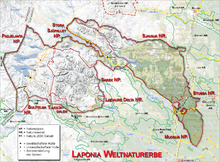
The Inlandsbanan railway goes through Laponia, with a stop at Porjus by Muddus and Stubba, and in Jokkmokk, 120 km from Kvikkjokk. The night train from Stockholm to Gällivare is also a popular option. The Malmbanan trains go via Murjek 180 km from Kvikkjokk.
There are several roads to the area, and buses to some of the nearby villages, such as Kvikjokk (from Jokkmokk and Murjek) and Stora Sjöfallet and Ritsem (from Gällivare). There is boat transport between some of the trailheads.
There are several helicopter operators, making it possible to directly reach some roadless destinations.
There are several hiking trails leading into the area. The most well-known (you can mostly use just a last leg; most trails described under Do below):
- Gränsleden/Rádjebálges leads from Tysfjord on the Norwegian coast to Áhkájávrre and Ritsem in Sweden, over the border by Nordkalottleden. It is an old trail, which has been used for trade, and during the World War it was used by refugees from the occupied Norway. Take a boat from Kjöpsvik to the trailhead in Sørfjorden (+47 75-77-43-29), call well in advance to allow coordination with other transports.
- Kungsleden from Hemavan
- Kungsleden from Abisko
- Nordkalottleden from Sulitjelma in Norway
- Nordkalottleden from Kautokeino or Kilpisjärvi
- Rallarstigen from Gällivare
You are free to enter Laponia where you choose to, but there is a visitor centre in Stora Sjöfallet (near the falls) and other official "entrances" in Jokkmokk, Gällivare, Porjus and Kvikkjokk.
Fees and permits
There are no entrance or hiking fees, but to use facilities of huts you have to pay. Paying in advance is appreciated (have your receipt), but in manned huts you can pay to the host, for unmanned huts paying afterwards is possible. You may also want to pay for transport, fishing or programme services.
Terms for fishing vary between different areas. Check for the waters where you intend to fish.
Do not disturb reindeer (especially not during calving times in spring or when they are moving between winter and summer pastures) or other wildlife, such as birds. Dogs on leashes are allowed in the national parks between 1 January and 30 April, and all year on some trails and in some areas. Pets are allowed in all the STF cabins.
Get around
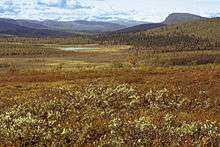
By foot mostly, by ski in winter (or by snowmobile along some routes). There are helicopter and boat services to some destinations.
At the trails there are usually bridges as needed. At some river crossings there are rowing boats. Leave a boat at each side. In Sarek fording will often be necessary, although there are also some bridges.
See
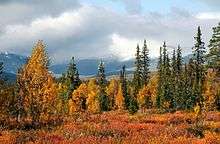
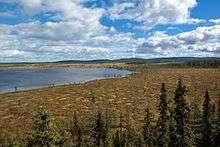
- The traditional lands of the Sami people.
- The Sulitelma massif and its glaciers, on the border to Norway. Sulitelma was long believed to be the highest mountain in Sweden.
- The largest wetland in Sweden, in Stubba, Sjaunja and Muddus. The Inlandsbanan railway (stop at Porjus) and Inlandsvägen tourist road (here synonymous to E45) go through Stubba.
- The Rapaselet delta in the Rapadalen valley in Sarek national park
- The old-growth forests and the Muddusjokk waterfall in Muddus.
- Stora Sjöfallet used to be one of the most impressing waterfalls in Europe, but most water is now lead underground via a hydroelectric plant.
- Lake Guvtjávrre by the Nordkalottleden trail, with view to the Áhkká massif. A meeting place for Sámi, with possibility to buy bread and fish with some luck.
Do

There are several well-known hiking trails through the area, and many other trails.
- Kungsleden, 430 km long from Abisko to Hemavan, through Laponia, is certainly the most famous. You can pick shorter legs.
- Nordkalottleden crosses the border to Norway here and there, and leads all the way from Sulitelma or Kvikkjokk to Kautokeino in Finnmark (some 800 km in all). Some legs are demanding.
- Padjelantaleden, 140 km long from Kvikkjokk northwards through Padjelanta National Park to Ritsem. You can get in by Kungsleden.
- Rallarstigen from Gällivare to Porjus, 44 km, passes through the northern end of Muddus. The trail has been used since the 18th century. Day hikes are possible from Inlandsvägen.
- Muttosbálges trails in southern Muddus.
Sarek is a popular fell tourism destination, but is challenging, as you in most of it have to get by without trails or huts. Also the fords can be dangerous at high waters.
Buy

Many of STF's mountain huts (See section "Lodging") have small convenience stores. These sell basic food and drink, but also practical utilities such as blister plasters, sunscreen, sanitary wipes, matches, toothpaste and maps. "Parfas kiosk" is located by the hut Stáloluokta and has a similar supply. The cabin Árasluokta offers traditional Sami handicraft.
Eat
Mostly you will eat what you have carried in. There is some food for sale at many huts (see section Lodging) and at some Sámi camps. There are cooking facilities in the huts, but a portable stove is recommended, for meals elsewhere.
There are also a few sites where you can buy a cooked meal. The cabins Kvikkjokk and Sáltoluokta and the Stora Sjöfallet Mountain Centre are large enough to have their own restaurants. Smaller cafés can be found at the visitors centre Naturum and in the cabin Ritsem.
Picking berries and edible mushrooms is allowed. Fishing is also allowed in many places, check what permits you need.
You may make fire when there is no risk of wildfire. Use dead branches and twigs. Do not move stones from fire rings.
Drink
There is plenty of good natural water in most areas. Most hikers use it untreated, but if you want to avoid risks, boiling it for a few minutes cannot hurt. Have bottles for carrying some.
All STF-shops offer milk and chocolate powder, coffee, tea, soda's and beers.
Several cabins have cafés or restaurants where you can get hot or cold drinks. The only proper bar in Laponia is located in the hotel "Stora Sjöfallet Mountain Center".
Sleep
- See also: Right to access in the Nordic countries
Lodging
- 🌍 Stora Sjöfallet Mountain Center (600 m North of the visitors center "Naturum"), ☎ +46 973-400 70, e-mail: info@storasjofallet.com. The only proper hotel in Laponia. They have a sauna, a restaurant offering traditional Lapland dishes, and even a bar.
Cabins
There are cabins along the main trails, manned in season. The cabins are operated by the Swedish Tourist Association (STF), Badjelánnda Laponia Turism (BLT) and Laponiatjuottjudus. The cabins are usually open from late June until September. In addition, most STF cabins are open in March and April. All sites operated by BTL leave one cabin open but unmanned around the year. All of Laponiatjuottjudus' cabins are unmanned but open around the year. You need at least own linen at most cabins. In Sarek you have to camp wild.
Clockwise around Sarek:
- 🌍 Kaitumjaure (Gáidumjávristugan). Operated by STF. It has a sauna and a shop.
- 🌍 Teusajaure (Dievssajávri). Operated by STF. It has a sauna and a shop.
- 🌍 Vakkotavare (Vákkudavárre). Operated by STF. It has a shop. Bus to Gällivare.
- 🌍 Sáltoluokta. Check-in: 12:00, check-out: 10:00. Operated by STF. One of the largest mountain stations in the reserve. It has a shop, wifi access, a sauna, and a restaurant. They also rent out fishing, skiing, canoeing and hiking equipment.
- 🌍 Sitojaure (Sijddojávrre). Operated by STF. Does not have any shop.
- 🌍 Aktse. Operated by STF. Has a sauna and a shop.
- 🌍 Pårte (Bårdde). Operated by STF. Only accepts cash payment. Does not have any shop.
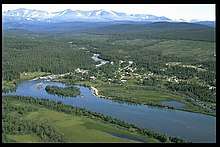
- 🌍 Kvikkjokk (Huhttán), ☎ +46 971 210 22, e-mail: info@kvikkjokkfjallstation.se. Operated by STF. One of the largest mountain stations in the reserve. They have a convenience store and a restaurant. They also rent out fishing and canoeing gear.
- 🌍 Tarrekaise (Darregájsse). Operated by STF. Has a shop, but only accepts cash payment.
- 🌍 Såmmarlappa (Såmmárlahpa). Operated by STF. Has a shop.
- 🌍 Darreluoppal (Tarreluobbal). Operated by BLT. Sell some very basic edibles.
- 🌍 Duottar. Operated by BLT. Sell some basic commodities.
- 🌍 Sårjåsjávrre. Operated by STF. Sell a few edibles.
- 🌍 Stáddájåhkå. Operated by BLT. Sell a few very basic edibles.
- 🌍 Stáloluokta. Operated by BLT. Has a sauna and a kiosk selling edibles and basic utilities.
- 🌍 Árasluokta. Operated by BLT. Sell a few edibles and some Sami handicraft.
- 🌍 Låddejåhkå. Operated by BLT. Sell a few edibles.
- 🌍 Kutjaure (Guvtjávrre). Operated by STF. Only accepts cash payment. Does not have any shop.
- 🌍 Gisuris. Operated by BLT. Sell a few very basic edibles.
- 🌍 Akka (Änonjálmme). Operated by STF. Has a sauna, but no shop.
- 🌍 Vaisaluokta (Vájsáluokta). Operated by STF. Only accepts cash payment. Does not have any shop.
- 🌍 Ritsem (Rijtjem). Operated by STF. One of the larger cabins in the reserve. They have a store, a sauna, wifi access and a café. They also offer rental bikes and rental fishing gear.
Muddus
- 🌍 The Arvidsson cabin.
- 🌍 Muttosluoppal. Operated by Laponiatjuottjudus.
- 🌍 Manson. Operated by Laponiatjuottjudus.
- 🌍 Muddusagahtjaldak (Fallstugan). Operated by Laponiatjuottjudus.
Camping
You can camp by most huts, for a fee.
Backcountry
.jpg)
Camping for a few days is allowed at most places.
Stay safe
Be prepared for cold weather. Also in summer temperatures can be quite low, and wind and rain can make staying warm a challenge. If caught in a snow storm, dig yourselves a hole in the snow.
Use guest books in the huts to indicate where you are going next.
If snow or fog makes navigation difficult, stay where you are. And reserve time for staying in a hut or in your camp one day more (or several, depending on your route), so that you can do so without worries.
Where there may be difficult fords, reserve enough time to be able to avoid a ford that turns out to be dangerous. Use local advice for the water situation.
Although there are well marked trails with huts not too far from each other, and in season also other people using the trails, remember that off trails this is wilderness. There is no guarantee of phone coverage and any help may have to be brought in by helicopter.
Mosquitoes and black flies are a severe nuisance in summer in most of Laponia, although they carry no illnesses. Long sleeves, insect repellent and a mosquito hat are strongly recommended. The problem is considerably smaller in high dry and windy areas (read: above the treeline).